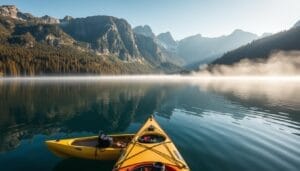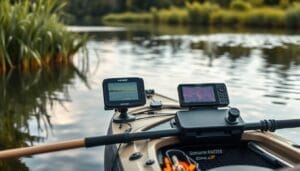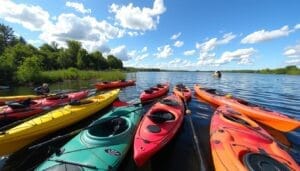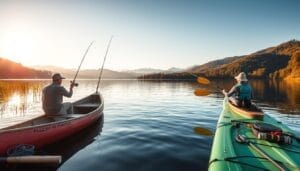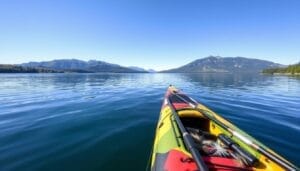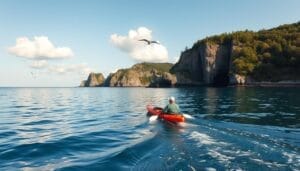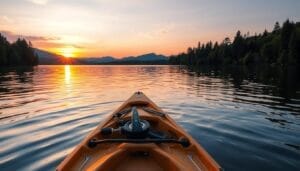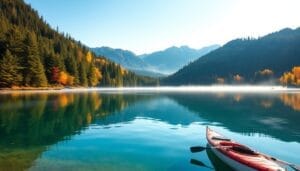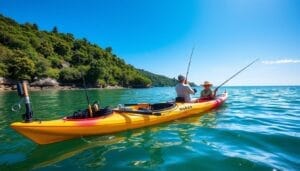1. Introduction to Kayak and Canoe Fishing in Canada
Kayak and canoe fishing offer an unparalleled way to connect with nature and access some of the most pristine and productive fishing spots in Canada. Imagine gliding silently across a glassy lake, casting your line into untouched waters, and feeling the tug of a fish on the other end. This isn’t just fishing; it’s an adventure.
This comprehensive guide will take you through everything you need to know to get started, from essential gear and techniques to the best locations across Canada. Whether you’re a seasoned angler or a complete beginner, you’ll find valuable information here to elevate your kayak and canoe fishing experience.
2. Why Choose Kayak or Canoe Fishing?
There’s a unique magic to kayak and canoe fishing that you just can’t find with larger motorized boats. Here’s why so many anglers are drawn to these methods:

- Unmatched Accessibility: Kayaks and canoes can navigate shallow waters, narrow rivers, and secluded coves that are inaccessible to larger boats, opening up a world of fishing opportunities.
- Cost-Effective: Compared to owning and maintaining a motorized boat, kayaks and canoes are far more affordable, making fishing more accessible to everyone.
- Environmentally Friendly: Powered by you, these vessels leave no carbon footprint, allowing you to enjoy the great outdoors with a clear conscience.
- A Great Workout: Paddling is a fantastic form of exercise, engaging your core and upper body while getting you to your favorite fishing hole.
- Immersive Nature Experience: Enjoy the peace and quiet of being on the water, observing wildlife, and feeling a deeper connection with the environment.
3. Essential Gear for Kayak and Canoe Fishing
Having the right gear can make or break your fishing trip. Here’s a breakdown of the essentials:
- The Kayak or Canoe:
- Kayaks:
- Sit-on-top kayaks are stable, easy to get in and out of, and popular for recreational fishing.
- Sit-inside kayaks are better for colder waters and longer trips, offering more protection from the elements.
- Consider factors like stability, weight capacity, storage, and length when choosing.
- Canoes:
- Recreational canoes are ideal for calmer waters and shorter fishing trips.
- Tripping canoes are designed for longer expeditions with more capacity and stability.
- Choose based on the number of people and the type of water you’ll be navigating.
- Kayaks:
- Paddles:
- Kayak Paddles: Double-bladed for efficient movement. Choose a paddle that is the correct length based on your height and kayak width.
- Canoe Paddles: Single-bladed. Choose a paddle length that allows you to reach the water comfortably without leaning too far.
- Consider lightweight materials like carbon fiber for longer days on the water.
- Personal Flotation Device (PFD):
- A properly fitting PFD is essential for your safety and is legally required. Choose a PFD that is comfortable to wear all day.
- Fishing Rods and Reels:
- Choose rod and reel combos based on the fish species you’re targeting. A medium-action rod is a good all-around choice.
- Consider bringing multiple rod and reel setups for different types of fishing.
- Tackle and Lures:
- Stock your tackle box with a variety of lures, hooks, weights, lines, and swivels.
- Bring along a variety of different styles and colors of lures.
- Do some research to see what local anglers have success with.
- Safety Gear:
- Whistle, first-aid kit, navigation tools (map, compass, or GPS), a knife, and a waterproof flashlight.
- Optional Gear:
- Fish finder to locate fish, an anchor to hold your position, rod holders for convenience, dry bags to keep your gear dry, polarized sunglasses to reduce glare, and sunscreen to protect you from the elements.
- How to Choose the Right Kayak Paddle for Fishing:
- Paddle Length: The right paddle length is crucial for efficient paddling and avoiding fatigue.
- Sit-on-Top Kayaks: Generally require a slightly shorter paddle compared to sit-inside kayaks due to the higher seating position.
- Sit-Inside Kayaks: Require a longer paddle to reach the water properly.
- Paddle Material:
- Aluminum: Durable and affordable but can be heavier. Best for beginners or those on a budget.
- Fiberglass: Lighter and more efficient than aluminum, a good mid-range option.
- Carbon Fiber: The lightest and stiffest option, maximizing power transfer. Best for serious paddlers or those who spend many hours on the water.
- Blade Shape:
- High-Angle Blades: Best for aggressive paddling and maneuvering.
- Low-Angle Blades: More relaxed paddling style suited for long distances.
- Paddle Length: The right paddle length is crucial for efficient paddling and avoiding fatigue.
- Choosing the Right Fishing Rod for Your Kayak:
- Rod Length: Shorter rods (6-7 feet) are generally better for kayak fishing as they are easier to handle in confined spaces.
- Rod Action:
- Medium-Action Rods: Versatile option for a wide variety of fish and lures.
- Fast-Action Rods: Sensitive and good for detecting subtle bites, particularly suitable for finesse techniques.
- Slow-Action Rods: Good for trolling with live bait.
- Rod Power:
- Medium-Light to Medium Power: Suitable for most freshwater fish species like bass, walleye, and trout.
- Medium-Heavy to Heavy Power: Needed for larger fish species like muskie or salmon.
- Rod Material:
- Graphite Rods: Lightweight, sensitive and more expensive
- Fiberglass Rods: Durable, more flexible and less expensive.
4. Basic Kayak and Canoe Fishing Techniques
Mastering a few key techniques will greatly enhance your success:
- Casting: Practice basic casting techniques, such as overhead, sidearm, and flip casts, to reach different fishing spots.
- Trolling: Slowly paddle while dragging a lure behind your kayak or canoe to cover a larger area and entice fish.
- Still Fishing: Anchor your kayak or canoe in a promising location and fish with bait or lures.
- Reading the Water: Look for structure (rocks, fallen trees, drop-offs) that might hold fish. Observe the surface for signs of feeding fish.
- Landing a Fish: Be gentle when bringing a fish to the kayak, using a net when appropriate. Handle fish with care if you plan to release it.
5. Best Locations for Kayak and Canoe Fishing in Canada
Canada boasts a vast array of incredible fishing destinations, each offering unique experiences and target species. Here’s an expanded look at some of the best locations for kayak and canoe fishing across the country:
- British Columbia:
- Coastal Waters (Vancouver Island, Haida Gwaii):
- Target Species: Salmon (Chinook, Coho, Sockeye, Pink, Chum), Halibut, Rockfish, Lingcod.
- Details: Explore the rugged coastline, sheltered bays, and inlets. Launch your kayak or canoe from various launch points or tour operators. These waters offer exciting opportunities for salmon and bottom fishing. Be aware of tides and currents and dress appropriately for the ocean weather. Consider hiring a local guide.
- Best Time: Summer and early fall for salmon runs. Year-round for other species depending on location.
- Interior Lakes (Okanagan, Kootenay):
- Target Species: Rainbow Trout, Kokanee, Lake Trout, Bull Trout.
- Details: Numerous pristine lakes surrounded by mountains and forests offer excellent trout fishing. Many have designated launch areas. Explore the shallows and deeper areas as needed, depending on the species.
- Best Time: Spring and fall for trout. Summer for kokanee.
- Skeena River System:
- Target Species: Steelhead, Salmon
- Details: A world-renowned area for steelhead and salmon. Explore various tributaries and the main river channel. The Skeena is a larger system, so exercise caution and check with local fishing guides about the best fishing areas.
- Best Time: Spring and Fall for steelhead, summer and fall for various salmon runs.
- Coastal Waters (Vancouver Island, Haida Gwaii):
- Alberta:
- Bow River (Near Calgary):
- Target Species: Brown Trout, Rainbow Trout.
- Details: A renowned fly-fishing river. The Bow is a great option for kayak and canoe anglers. Explore various access points and fish the pools and riffles for trout. There are several guides and outfitters that offer guided fishing tours in this area.
- Best Time: Spring, summer, and fall for trout.
- Abraham Lake (Near Banff National Park):
- Target Species: Bull Trout, Lake Trout.
- Details: A beautiful lake with stunning mountain views. Explore the shoreline and deeper parts of the lake for trout.
- Best Time: Summer and early fall for trout.
- Bow River (Near Calgary):
- Saskatchewan:
- Lake Diefenbaker:
- Target Species: Walleye, Pike, Rainbow Trout, Lake Trout
- Details: A large lake with various bays and inlets to explore. Fish the shorelines for walleye and pike, and explore deeper water for trout.
- Best Time: Spring and Fall for Walleye and Pike, Summer and early fall for trout.
- Churchill River System:
* Target Species: Walleye, Pike, Lake Trout
* Details: A scenic river system with many lakes and rapids. Fish the slower-moving areas for walleye and pike. The more remote parts of this system offer excellent lake trout fishing opportunities.
* Best Time: Summer and early fall for various species.
- Lake Diefenbaker:
- Manitoba:
- Lake Winnipeg:
- Target Species: Walleye, Pike, Perch, Sauger.
- Details: A large lake with vast shorelines and numerous islands. Known for its world-class walleye and pike fishing. Check the weather as lake Winnipeg can get rough. Explore various bays and reefs for fishing. Consider hiring a local guide.
- Best Time: Spring and fall for walleye and pike, summer for perch.
- Whiteshell Provincial Park:
* Target Species: Walleye, Pike, Lake Trout, Smallmouth Bass
* Details: Numerous lakes and rivers provide plenty of options for kayak and canoe anglers. Many easily accessible boat launches are available in the park.
* Best Time: Spring, summer and fall for various species
- Lake Winnipeg:
- Ontario:
- Algonquin Provincial Park:
- Target Species: Lake Trout, Smallmouth Bass, Brook Trout, Walleye.
- Details: A vast park with numerous lakes and rivers offering a true backcountry experience. Portaging between lakes is possible, but plan accordingly. Check the park website for necessary permits and regulations.
- Best Time: Spring and fall for lake trout, summer for bass and walleye.
- Thousand Islands Region (St. Lawrence River):
- Target Species: Largemouth Bass, Smallmouth Bass, Pike, Muskellunge.
- Details: Explore the scenic islands and bays of the St. Lawrence River. Fish the weed beds and rock structures for bass and pike.
- Best Time: Summer and early fall for bass and pike.
- Algonquin Provincial Park:
- Lake Nipissing:
- Target Species: Walleye, Pike, Bass, Muskellunge
- Details: A large lake with many bays and islands. There are many boat launches and campsites in the area. Walleye and Pike are the main target species. Check the weather as Lake Nipissing can get rough.
- Best Time: Spring and Fall for walleye, summer for bass and muskie
- Quebec:
- St. Lawrence River (Near Montreal):
- Target Species: Muskellunge, Walleye, Smallmouth Bass, Northern Pike.
- Details: A large river system offering various fishing opportunities. Focus on bays, inlets, and around islands for target species. Check the regulations carefully, as certain areas are closed for spawning.
- Best Time: Summer and early fall for muskie and bass.
- Laurentian Mountains (Numerous Lakes):
- Target Species: Brook Trout, Lake Trout, Landlocked Salmon.
- Details: Explore the countless lakes dotted throughout the Laurentians. Most are accessible by forest roads. Check with local authorities for permits and access information.
- Best Time: Spring and fall for trout.
- Gaspésie Peninsula:
- Target Species: Atlantic Salmon, Brook Trout
- Details: Renowned for its salmon rivers. Various rivers offer salmon and trout fishing. Hire a local guide for the best experience.
- Best Time: Spring and Summer for Atlantic Salmon, summer for Brook Trout
- St. Lawrence River (Near Montreal):
- Atlantic Provinces:
- Nova Scotia (Lakes and Rivers):
- Target Species: Brook Trout, Brown Trout, Atlantic Salmon.
- Details: Explore the numerous lakes and rivers for trout and salmon. Be aware of specific regulations.
- Best Time: Spring and fall for trout and salmon runs.
- New Brunswick (Miramichi River, Saint John River):
- Target Species: Atlantic Salmon, Brook Trout.
- Details: These rivers are famous for Atlantic salmon. Explore the upper and lower sections of these rivers. Hire a local guide to navigate the best fishing areas.
- Best Time: Spring and summer for salmon.
- Prince Edward Island (Rivers and Coastal Waters):
- Target Species: Brook Trout, Rainbow Trout, Mackerel.
- Details: Explore the numerous rivers and coastal areas for various fishing opportunities.
- Best Time: Spring and summer for trout, summer for mackerel
- Nova Scotia (Lakes and Rivers):
6. Dive Deeper: Mastering the Art of Kayak & Canoe Fishing
Target Species & Techniques: A Detailed Guide
This section will help you understand the nuances of targeting specific fish species commonly found in Canadian waters. Knowing their habitat, preferred lures, and seasonal behavior will significantly enhance your chances of success.
- Walleye: The Elusive Predator
- Habitat: Walleye prefer lakes and rivers with rocky bottoms, weed beds, and areas with current. They often lurk in deeper water during the day, moving to shallower areas to feed at dawn and dusk.
- Lures and Techniques:
- Jigs: Vertical jigging with a lead head jig tipped with a minnow or soft plastic is highly effective.
- Crankbaits: Trolling or casting crankbaits along shorelines and drop-offs can entice walleye.
- Live Bait: Leeches, nightcrawlers, and minnows are excellent live bait options when fished with a jig or a slip bobber.
- Techniques: Try slow trolling, casting and retrieving, vertical jigging, or drifting with live bait.
- Seasonal Behavior: In spring, walleye are often found in shallow spawning areas. In the summer, they move to deeper, cooler water during the day. In the fall, they return to shallower waters to feed before winter. They are most active at dawn and dusk.
- Trout (Rainbow, Brook, Lake):
- Habitat: Varies by species, but generally found in clear, cold waters. Rainbow trout prefer lakes and rivers with fast currents. Brook trout are often found in smaller streams and ponds. Lake trout prefer deep, cold lakes.
- Lures and Techniques:
- Small Spoons and Spinners: Effective for casting and trolling.
- Small Minnow-Imitating Crankbaits: Good for attracting trout in various depths.
- Dry Flies and Nymphs (Fly Fishing): Excellent for surface and subsurface presentations.
- Live Bait: Worms, salmon eggs, and other live baits can be very effective.
- Seasonal Behavior: Trout are often more active in cooler water temperatures, so spring and fall are ideal times to target them. They tend to be more active during low-light conditions.
- Bass (Largemouth and Smallmouth):
- Habitat: Largemouth bass prefer warmer, weedy waters with plenty of cover. Smallmouth bass like rocky shorelines, points, and clearer water with some current.
- Lures and Techniques:
- Topwater Lures: Frogs, poppers, and walking baits are excellent for surface action.
- Jigs and Soft Plastics: Versatile for fishing near structures and in deeper areas.
- Crankbaits and Spinnerbaits: Good for covering water and triggering aggressive strikes.
- Live Bait: Crayfish and worms are effective, especially for slower presentations.
- Seasonal Behavior: Bass are more active in the warmer months. They will be found in shallow spawning areas in the spring, and will move to deeper areas in the summer. They will become more active again before the winter.
- Pike (Northern Pike):
- Habitat: Pike prefer weedy bays, shallow areas and edges of drop-offs in lakes and rivers.
- Lures and Techniques:
- Large Spoons and Spinnerbaits: Effective for attracting pike.
- Large Minnow-Imitating Crankbaits: Good for trolling.
- Large Soft Plastic Lures: Ideal for fishing near vegetation.
- Seasonal Behavior: Pike tend to be very aggressive in the spring when they spawn in shallow weedy bays. As water temps rise, they will seek cooler deeper waters. They will move into the shallows in the fall to feed before winter.
- Salmon (Chinook, Coho, Sockeye, Pink, Chum, Atlantic):
- Habitat: Varies by species, but generally found in coastal waters, rivers, and lakes. Atlantic Salmon are found in rivers and streams in the eastern parts of Canada. Pacific Salmon species are found in the coastal waters of British Columbia and rivers that drain into the Pacific.
- Lures and Techniques:
- Spoons and Spinners: Classic lures for casting and trolling.
- Plugs and Wobblers: Effective for targeting larger salmon in deeper water.
- Live or Cut Bait: Herring or anchovies can be used for trolling or mooching.
- Seasonal Behavior: Salmon are migratory fish, and their behavior changes with the different phases of their life cycle. The best time to target them is during their spawning runs.
Lure & Bait Recommendations by Species
To further guide your selection, here is a table summarizing the recommended lures and baits for each of the species mentioned above:
| Fish Species | Recommended Lures/Baits |
| Walleye | Jigs (with minnows/plastics), Crankbaits, Leeches, Nightcrawlers, Minnows |
| Rainbow Trout | Small Spoons/Spinners, Small Crankbaits, Dry Flies, Nymphs, Worms |
| Brook Trout | Small Spoons/Spinners, Dry Flies, Nymphs, Worms, Salmon Eggs |
| Lake Trout | Large Spoons, Crankbaits, Tube Jigs, Spoons |
| Largemouth Bass | Topwater Lures, Jigs, Soft Plastics, Crankbaits, Spinnerbaits, Crayfish, Worms |
| Smallmouth Bass | Topwater Lures, Jigs, Soft Plastics, Crankbaits, Spinnerbaits, Crayfish, Worms |
| Pike | Large Spoons, Spinnerbaits, Large Crankbaits, Large Soft Plastics |
| Salmon | Spoons, Spinners, Plugs, Wobblers, Herring, Anchovies, Cut Bait |
(Note: It’s important to always check local regulations regarding the use of live bait and other specific restrictions.)
Seasonal Fishing Strategies:
- Spring Fishing: After ice-out, fish are often hungry and aggressive. Focus on shallow areas with warmer water. Target walleye, bass, and trout during their spawning periods.
- Summer Fishing: Fish may move to deeper cooler waters during the day. Fish early mornings and late evenings. Use techniques such as trolling or deep-water jigging.
- Fall Fishing: As water temperatures cool, fish become more active again, often feeding heavily before winter. Focus on areas near spawning grounds for trout, salmon, and walleye.
- Ice Fishing (Where Applicable and Safe): Be aware of the risks associated with ice fishing from a kayak. Ice fishing can be done from the shore, but should only be done from a kayak with extreme caution and the proper gear for the weather.
Advanced Techniques:
- Using a Fish Finder Effectively:
- Learn to interpret fish finder readings and locate fish and structure.
- Adjust the sensitivity and frequency to see fish holding structure.
- Use it to determine the depth and temperature of the water.
- Fly Fishing from a Kayak or Canoe:
- Use shorter, more maneuverable fly rods for fishing in tighter areas.
- Practice fly casting while sitting down.
- Target trout and other fish in shallow water.
- Essential Fishing Knots:
- Improved Clinch Knot: A common knot for attaching lures and hooks.
- Palomar Knot: Strong and reliable knot for braided lines.
- Uni Knot: Versatile knot for various applications.
- Surgeon’s Knot: Good for tying two lines together.
7. Safety Tips for Kayak and Canoe Fishing
Your safety should always be your priority.

- Weather: Always check the forecast before heading out and be prepared for changing conditions. Postpone your trip if severe weather is predicted.
- Water Conditions: Be aware of currents, tides, and water levels, especially on rivers.
- Navigation: Use maps, compasses, or GPS devices to stay on course, especially in unfamiliar areas.
- Emergency Preparedness: Have a plan in case of emergencies. Carry a first-aid kit, a whistle, and a waterproof communication device if possible.
- Hypothermia: Dress in layers, wear appropriate clothing for the water temperature, and have a plan for getting warm quickly if you get wet.
- Wildlife Encounters: Be aware of local wildlife, including bears, moose, and other animals. Keep a safe distance and do not approach them.
8. Regulations and Licenses
- Fishing regulations vary by province and territory.
- A valid fishing license is required to fish in Canada.
- Obtain your license from the provincial or territorial government where you plan to fish.
- Familiarize yourself with the specific rules and regulations, including size and catch limits.
- Practice ethical fishing by respecting the environment and releasing fish unharmed whenever possible.
- (Include links to relevant government websites)
9. Tips for Beginners

- Start slow and in calm waters near shore.
- Practice paddling and casting before heading to a remote area.
- Go with an experienced angler for your first few trips.
- Start with short trips to build up your comfort level.
- Pack plenty of water, snacks, sunscreen, and other essentials.
- Be patient and persistent; learning to fish takes time and practice.
10. Conclusion
Kayak and canoe fishing in Canada offers an incredible opportunity to connect with nature, enjoy the outdoors, and catch a variety of fish species. With the right gear, knowledge, and safety precautions, you can have amazing adventures.
So, grab your paddle, pack your gear, and start planning your trip. The waters of Canada are waiting!
11. Frequently Asked Questions (FAQ)
This section addresses common questions about kayak and canoe fishing in Canada, helping you prepare for your next adventure.
- Q: Do I need a fishing license to fish from a kayak or canoe in Canada?
- A: Yes, a valid fishing license is required to fish in any Canadian province or territory. Regulations vary by location, so it’s important to purchase the appropriate license from the relevant provincial or territorial government. You’ll typically need a resident or non-resident license based on your place of residence.
- Q: What type of kayak is best for fishing?
- A: The best kayak for fishing depends on your needs and preferences. Sit-on-top kayaks are popular for their stability and ease of entry/exit, making them great for recreational fishing. Sit-inside kayaks provide more protection from the elements and are better for longer trips and colder waters. Consider the kayak’s stability, weight capacity, storage, and length when choosing.
- Q: What is the best type of canoe for fishing?
- A: Recreational canoes are suitable for calmer waters and shorter fishing trips. Tripping canoes are designed for longer expeditions with more capacity and stability. Choose based on the number of people and the type of water you’ll be navigating. Canoes offer more stability compared to kayaks, but can be harder to control.
- Q: What kind of paddle should I use for kayak fishing?
- A: For kayak fishing, a double-bladed paddle is essential. Consider paddle length based on your height and kayak width. Lightweight materials like carbon fiber can reduce fatigue on longer trips. The blade type (high angle vs. low angle) will depend on your paddling style and the type of water you are navigating.
- Q: What kind of paddle should I use for canoe fishing?
- A: For canoe fishing, a single-bladed paddle is used. A longer paddle is better for fishing from a canoe as it can give you more leverage, and reduces the amount of bending you will need to do. Choose a paddle length that allows you to comfortably reach the water without leaning too far.
- Q: What are some essential safety items to bring on a kayak or canoe fishing trip?
- A: Always bring a properly fitted PFD (life jacket), a whistle, a first-aid kit, navigation tools (map, compass, or GPS), a knife, a waterproof flashlight, and a communication device if possible.
Also, consider the weather conditions, and ensure you are dressed appropriately.
- A: Always bring a properly fitted PFD (life jacket), a whistle, a first-aid kit, navigation tools (map, compass, or GPS), a knife, a waterproof flashlight, and a communication device if possible.
- Q: How do I choose the right fishing rod for kayak or canoe fishing?
- A: Choose shorter rods (6-7 feet) that are easier to handle in the confined space of a kayak or canoe. Consider a medium-action rod as a versatile option, or specific rod actions based on the fish you are targeting.
- Q: What are some effective fishing techniques for kayak and canoe fishing?
- A: Effective techniques include casting, trolling (slowly paddling while dragging a lure), still fishing (anchoring and fishing a specific spot), and vertical jigging (dropping a jig straight down).
- Q: How do I read the water to find good fishing spots from a kayak or canoe?
- A: Look for structure (rocks, fallen trees, drop-offs), weed beds, and areas with current. Observe the surface for signs of feeding fish. Understanding the depth and temperature of the water can also be very helpful.
- Q: What are the best lures to use for kayak or canoe fishing in Canada?
- A: The best lures depend on the fish you’re targeting. For walleye, jigs and crankbaits are effective. For trout, small spoons, spinners, and flies work well. For bass, topwater lures, jigs, and soft plastics are excellent choices. Always refer to the “Lure & Bait Recommendations” section of this guide for more details.
- Q: How do I handle fish safely for catch and release?
- A: Use a net to land fish gently. Wet your hands before handling the fish to protect its slime coat. Avoid squeezing the fish and remove hooks carefully. Keep the fish in the water when possible and release it quickly.
- Q: How can I minimize my impact on the environment while kayak and canoe fishing?
- A: Practice Leave No Trace principles. Pack out all your trash, avoid disturbing wildlife or vegetation, and respect the natural environment. Use lead-free tackle whenever possible, and always use biodegradable cleaners and soaps.
- Q: Can I ice fish from a kayak or canoe?
- A: Ice fishing from a kayak or canoe is extremely dangerous and not recommended. Ice fishing should be done from the shore, and should only be done from a kayak or canoe with extreme caution and the proper gear for the weather. Always check the ice thickness and other local conditions before heading out onto the ice.
- Q: What should I do if I encounter wildlife while kayak or canoe fishing?
- A: Maintain a safe distance from wildlife. Avoid approaching or feeding animals. Store food properly to prevent attracting wildlife. If you encounter aggressive wildlife, slowly back away or take a different route.
- Q: Can I bring a dog with me on my kayak or canoe fishing trip?
- A: It is possible to bring your dog, however it is important to consider your dog’s personality and if it is comfortable on the water. Ensure your dog wears a well-fitting PFD. Pack water and snacks for your dog, and keep a leash handy. Be aware of your dog’s behavior and take extra safety precautions while paddling.
- Q: Where can I find more information on kayak or canoe fishing regulations in Canada?
- A: Refer to the provincial or territorial government websites for specific regulations in your area. We have included links to these websites in the “Regulations and Licenses” section of this guide.
Kayak Fishing in Remote Areas: Tips for an Unforgettable Adventure
Discover essential tips and gear recommendations for kayak fishing in remote areas across Canada's w…
Read MoreKayak Fishing with Electronics: Fish Finders and More
Discover essential tips for kayak fishing with electronics and learn how to choose the best fish fin…
Read MoreBest Kayak Models for Fishing: Find Your Perfect Ride
Discover the best kayak models for fishing with our comprehensive guide. We review top-rated options…
Read MoreCanoe vs. Kayak Fishing: Which is Right for You?
Discover the key differences between canoe vs. kayak fishing: pros and cons to help you choose the p…
Read MoreMaster Fly Fishing from a Kayak: A Comprehensive Guide
Discover expert tips and techniques for fly fishing from a kayak. Learn essential gear, safety measu…
Read MoreOcean Kayak Fishing in Canada: Tips for Saltwater Success
Discover essential tips and techniques for ocean kayak fishing in Canada. From gear selection to saf…
Read MoreCatch and Release Techniques for Kayak Anglers
Learn essential catch and release techniques for kayak anglers to protect fish populations and ensur…
Read MoreTop Canadian Lakes for Kayak Fishing: Where to Cast Your Line
Discover the best spots for Top Canadian Lakes for Kayak Fishing. From pristine waters to abundant c…
Read MoreShoreline Fishing from a Kayak: Tips for a Productive Day on the Water
Discover essential tips for shoreline fishing from a kayak and maximize your catches. Learn about ge…
Read More